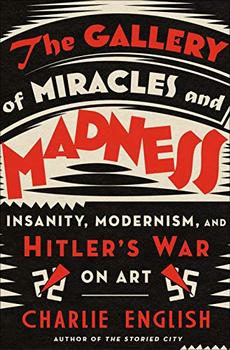Summary | Excerpt | Reviews | Beyond the Book | Readalikes | Genres & Themes | Author Bio

Insanity, Modernism, and Hitler's War on Art
by Charlie English1.
The Man Who Jumped in the Canal
On a winter's day in 1898, a stocky young man with a handlebar mustache was hurrying along the banks of a canal in Hamburg, north Germany. Pohl, as the world would come to know him, was in his early thirties then, a dapper individual who liked to carry a cane or umbrella and to wear a stovepipe hat over his oiled, ink-dark hair. At this particular instant, though, such considerations were far from Pohl's mind. He moved along in a private cloud of fear, rushing to escape the mysterious agents who tormented him. He didn't know who these men were—they could pop up in any guise, anywhere, at almost any time—but he did have a pretty good idea who sent them.
It had begun in Strasbourg, a German city at this time, at a moment of great professional humiliation: his sacking from the city's School of Arts and Crafts. The school's director, not content with ruining a brilliant career, had sent spies to snoop on Pohl, to listen at his keyhole, forcing him to change lodgings again and again. In the end there had been nothing for it but to leave town altogether. Pohl moved to Hamburg, at the other end of the country, and tried to lose himself in the louche entertainments of the city's vast red-light district, spending heavily on prostitutes and peep shows. Somehow his enemies tracked him down even here. Strangers threatened him in the street. He was accosted on the horse-drawn tram, singled out by the conductor, who yelled "He's crazy!" in front of the other passengers. Pimps shouted "Rascal!," "Thug!," "Kill him!," and the like. Even at the theater, he noticed the actors onstage delivering odd, barbed messages, targeted directly at him.
On this March day, he knew they were closing in.
Hamburg, the great port city on the river Elbe, the "Gateway to the World," home to the fleet of oceangoing liners that carried Germans to Boston and Baltimore, Hoboken and Hong Kong, was a latticework of inlets and lakes, channels and streams. Pohl now found his escape route barred by water. There was only one option: He must swim. At the end of winter, the canal was close to freezing, but he plunged in anyway. The dark liquid engulfed him in its shocking embrace, then he was splashing out for the far bank.
When, at length, he was hauled out onto dry land, soaked and shivering, it was clear to passersby that not everything was well with the strange swimmer. There was no sign of a chasing pack. No one, in fact, seemed to be following him at all. He was disturbed, confused, perhaps insane. So he was brought to the gates of the Friedrichsberg "madhouse," the giant institution that stood on a hill in the northeast of the city, and taken inside. He would remain in the dubious care of the psychiatric system for the next forty-two years, one of hundreds of thousands of inmates who lived precarious, near-invisible lives behind the walls of Germany's asylums.
"Pohl" was the alias used to spare his family the taint of mental illness. The man's real name was Franz Karl Bühler. He was a blacksmith by profession, though that word hardly does him justice. In fact, Bühler was one of the world's leading metalworkers at a time when the Arts and Crafts movement had pushed the form to unprecedented heights. Working with the 2,500-degree heat of the furnace, he could transform coarse pig iron into something malleable and delicate. By drawing it and bending it, upsetting, punching, and welding it, he was able to mimic flowers, grasses, and reed stalks so perfectly you had to touch them to know they weren't real. But something had happened to Bühler, an inner derailment of sorts, which interfered with his sense of reality and put him at the mercy of his own fictions and delusions. Doctors examining him over the following months and years would attach different labels to his condition, but the one that would stick was "schizophrenia."
Schizophrenia, the most severe of mental illnesses, remains the hardest to understand. Even articulate people with the condition find it difficult to explain the condition, beyond a sense of strangeness, alienation, or uncanniness. It is "a country, opposed to Reality, where reigned an implacable light," according to one account, where "people turned weirdly about," making nonsensical gestures and movements. Others describe it as a feeling of disintegration, or like looking at the world through a telescope backward. Some psychiatrists believe that where most people organize their perceptions into an overall picture of the world which they then act upon, those with schizophrenia combine unrelated pieces of sensory data that can only be understood by making irrational intellectual leaps. Hence Bühler, obsessed with his persecutors in Strasbourg, might hear a tram conductor shouting "He's crazy!" when he was just calling out the next stop. But not all manifestations are alike, and not everyone affected finds the condition debilitating. Some view it as an "enhancement" that gives them unusually deep insight. Only around a third of cases are now considered progressive, and most people with schizophrenia live full and active lives. When Bühler was hospitalized, however, the diagnosis was brand-new, and was thought to herald an irreversible decline. There was nothing to be done, his doctors believed. It was just a matter of time.
Excerpted from The Gallery of Miracles and Madness by Charlie English. Copyright © 2021 by Charlie English. All rights reserved. No part of this excerpt may be reproduced or reprinted without permission in writing from the publisher.
Your guide toexceptional books
BookBrowse seeks out and recommends the best in contemporary fiction and nonfiction—books that not only engage and entertain but also deepen our understanding of ourselves and the world around us.